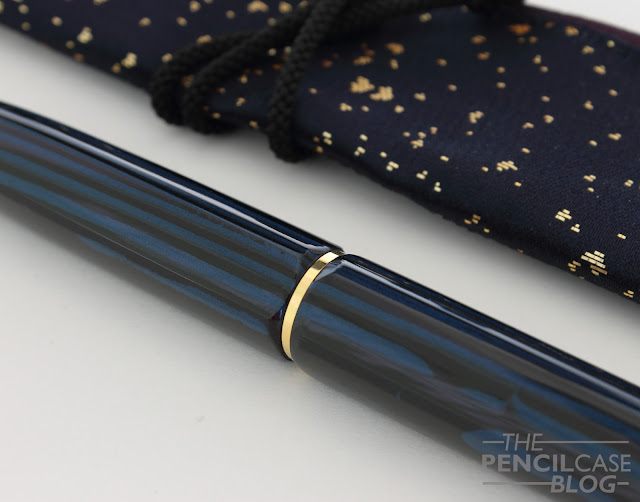Yes. I'm well-aware of the fact that I don't review enough Japanese fountain pens. It's something I haven't put my focus on yet, which has previously always been European brands (like Pelikan, Lamy, or the many Italian brands). But every now and then I get the opportunity to review something really cool. Something I wouldn't immediately buy myself.
I recently got the opportunity to take a look at the new Sailor ZuiSei 105th anniversary pen, provided by the German-based store Papier & Stift! This is definitely not a pen I'd buy on my own initiative, but that's just a decision based on my budget. If I had the money...
The ZuiSei is a unique pen in a couple of ways. First of all: the remarkable and unusual pentagonal profile throughout the entire cap and body of the pen, but also the beautiful blue-black striped ebonite! |
| The experience starts with the balsa-wood box, inside is a rice-paper envelope with warranty and information booklets, and a beautiful blue pen kimono. |
The ebonite is absolutely stunning, but as Brad -penaddict- Dowdy mentioned on Instagram, it's also one of the hardest materials to photograph. The color variation is noticeably more pronounced in person than it'll appear in these pictures, with petrol-blue, black and grey stripes. Unlike acrylic, ebonite doesn't have depth, but the striped pattern looks so crisp, and the pentagonal profile does a great job showing off the different streaks of color. A neat little detail is that the pattern in the ebonite on the cap and barrel line up.
 |
| L to R: Pelikan M800, Pelikan M1000, Sailor Zuisei, Omas Arte Italiana Paragon, Lamy safari, Lamy 2000 |
Something I didn't expect, was how big this pen is. Usually, Sailor makes fairly small, maybe medium-sized pens, but this isn't just big, it's oversized! At 16cm (6.3in) capped, and 13.9cm (5.5in) uncapped, this pen easily beats anything I have in my personal collection. My Omas Paragon looks small in comparison, the M1000 next to it just looks downright tiny! Despite the completely ebonite construction, it has a satisfying weight to it (around 40 grams total).
It's quite a wide pen as well, or at least on the outside where it measures approximately 1.7cm (0.66in) in diameter. Underneath the cap, I was suprised to find a small black plastic section, and the same nib size as found on the 1911 Large and Pro Gear. I can understand that they reuse an existing section and nib, but I would've expected at least one in the King Of Pens size (one step up from the regular models). Not only would it have matched the huge cap and barrel of the ZuiSei better, it would've also been more fitting on a pen in this price class!
 |
| The biggest pen of the lot, but one of the smallest nibs... |
I was a bit worried about comfort with a huge pen like this, but in the end it's really not that bad. The pen has a snap cap, so there are no threads to worry about. There is a little step towards the barrel, but the transition is relatively easy on the fingers, even if you hold it right there. I also think the wide barrel helps in providing a less cramped grip. I personally prefer slightly wider pens, but of course your mileage may vary on that. In any case, I found it to be a surprisingly comfortable pen to write with, despite the fact that it's really more of a collector's piece than it is an everyday carry pen!
 |
| Limited edition of 500 pieces |
Part of the reason why I enjoyed using it so much, is the nib. It's visually dissapointing because it's so small (the nib itself looks good, but it just feels out of place on a big pen like this). But performance-wise it scores top marks.
That's actually an odd thing to say for someone like me that is used to western nibs. Not that Japanese nibs aren't good, quite the opposite, but they aren't exactly in line with what I usually prefer: smoothness, softness, and a wide nib. I like my double broads, so Japanese extra-extra fine nibs aren't exactly my cup of tea!
Luckily, Papier und Stift knew my preferences, and they sent one with a Broad nib. It still has Japanese characteristics, but I found it to be remarkably close to what I would call the ideal broad nib! It's stiff, but has a wonderfully wet ink flow (especially when paired with the already wet Sailor Jentle inks). The tipping is ground in a rather wide contact spot, so line width is actually not that far off from Western standards.
As is to be expected from Japanese nibs, they are tuned to write unconditionally. That means you'll clearly notice some feedback when you write -similar to a graphite pencil-. This is the kind of feedback you want, it doesn't catch on the paper, and it writes all the time. Japanese brands -contrary to some Western brands- don't overpolish their nibs, which makes them less temperamental and more consistent. So far this theory still holds true, as I didn't experience a single hesitation or skip. Even with fast writing, it would still keep a consistently wet flow.
Note: this pen was lent to me by Papier & Stift, free of charge, so I could write this review. I was in no way influenced in the making of this review, the opinions shared in this review are completely my own! This post does not contain affilate links.








Your blog has good looking. Nice picture. You have to include more information about this topic. Try to write all that information in your own words.
ReplyDelete